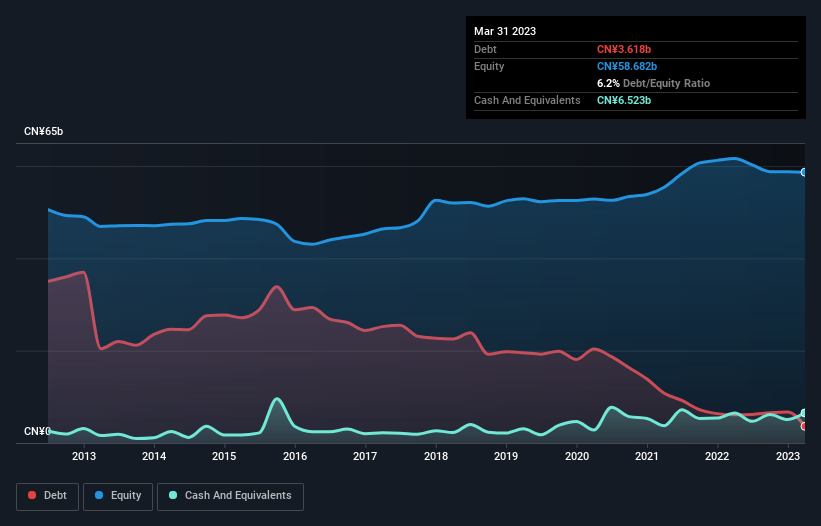The external fund manager backed by Berkshire Hathaway's Charlie Munger, Li Lu, makes no bones about it when he says 'The biggest investment risk is not the volatility of prices, but whether you will suffer a permanent loss of capital.' It's only natural to consider a company's balance sheet when you examine how risky it is, since debt is often involved when a business collapses. Importantly, Angang Steel Company Limited (HKG:347) does carry debt. But should shareholders be worried about its use of debt?
When Is Debt A Problem?
Generally speaking, debt only becomes a real problem when a company can't easily pay it off, either by raising capital or with its own cash flow. Part and parcel of capitalism is the process of 'creative destruction' where failed businesses are mercilessly liquidated by their bankers. However, a more frequent (but still costly) occurrence is where a company must issue shares at bargain-basement prices, permanently diluting shareholders, just to shore up its balance sheet. By replacing dilution, though, debt can be an extremely good tool for businesses that need capital to invest in growth at high rates of return. When we examine debt levels, we first consider both cash and debt levels, together.
See our latest analysis for Angang Steel
What Is Angang Steel's Debt?
The image below, which you can click on for greater detail, shows that Angang Steel had debt of CN¥3.62b at the end of March 2023, a reduction from CN¥6.11b over a year. However, it does have CN¥6.52b in cash offsetting this, leading to net cash of CN¥2.91b.

How Strong Is Angang Steel's Balance Sheet?
According to the last reported balance sheet, Angang Steel had liabilities of CN¥38.0b due within 12 months, and liabilities of CN¥3.09b due beyond 12 months. On the other hand, it had cash of CN¥6.52b and CN¥5.40b worth of receivables due within a year. So its liabilities outweigh the sum of its cash and (near-term) receivables by CN¥29.2b.
When you consider that this deficiency exceeds the company's CN¥25.6b market capitalization, you might well be inclined to review the balance sheet intently. In the scenario where the company had to clean up its balance sheet quickly, it seems likely shareholders would suffer extensive dilution. Angang Steel boasts net cash, so it's fair to say it does not have a heavy debt load, even if it does have very significant liabilities, in total. There's no doubt that we learn most about debt from the balance sheet. But it is future earnings, more than anything, that will determine Angang Steel's ability to maintain a healthy balance sheet going forward. So if you want to see what the professionals think, you might find this free report on analyst profit forecasts to be interesting.
Over 12 months, Angang Steel made a loss at the EBIT level, and saw its revenue drop to CN¥127b, which is a fall of 8.8%. We would much prefer see growth.
So How Risky Is Angang Steel?
While Angang Steel lost money on an earnings before interest and tax (EBIT) level, it actually generated positive free cash flow CN¥2.1b. So although it is loss-making, it doesn't seem to have too much near-term balance sheet risk, keeping in mind the net cash. We're not impressed by its revenue growth, so until we see some positive sustainable EBIT, we consider the stock to be high risk. When we look at a riskier company, we like to check how their profits (or losses) are trending over time. Today, we're providing readers this interactive graph showing how Angang Steel's profit, revenue, and operating cashflow have changed over the last few years.
At the end of the day, it's often better to focus on companies that are free from net debt. You can access our special list of such companies (all with a track record of profit growth). It's free.
New: Manage All Your Stock Portfolios in One Place
We've created the ultimate portfolio companion for stock investors, and it's free.
• Connect an unlimited number of Portfolios and see your total in one currency
• Be alerted to new Warning Signs or Risks via email or mobile
• Track the Fair Value of your stocks
Have feedback on this article? Concerned about the content? Get in touch with us directly. Alternatively, email editorial-team (at) simplywallst.com.
This article by Simply Wall St is general in nature. We provide commentary based on historical data and analyst forecasts only using an unbiased methodology and our articles are not intended to be financial advice. It does not constitute a recommendation to buy or sell any stock, and does not take account of your objectives, or your financial situation. We aim to bring you long-term focused analysis driven by fundamental data. Note that our analysis may not factor in the latest price-sensitive company announcements or qualitative material. Simply Wall St has no position in any stocks mentioned.
About SEHK:347
Angang Steel
Engages in the production, processing, and sale of steel products in the People’s Republic of China and internationally.
Fair value with moderate growth potential.
Similar Companies
Market Insights
Community Narratives




